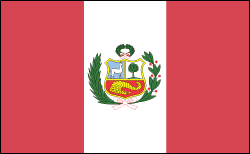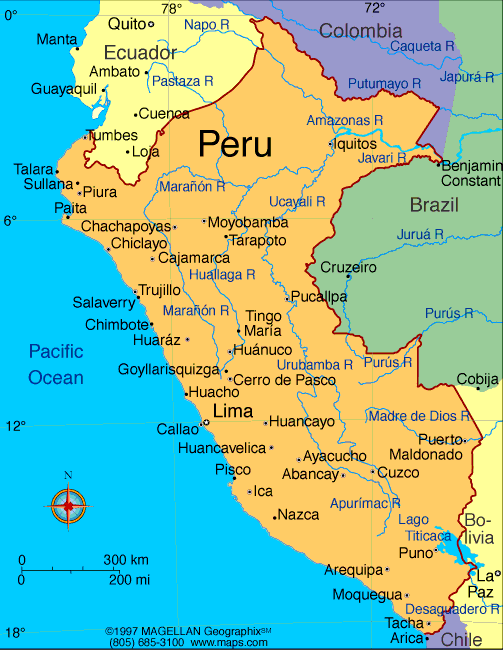PERU

Geography: Peru, in western South America, extends for nearly 1,500 mi (2,414 km) along the Pacific Ocean. Colombia and Ecuador are to the north, Brazil and Bolivia to the east, and Chile to the south. Five-sixths the size of Alaska, Peru is divided by the Andes Mountains into three sharply differentiated zones. To the west is the coastline, much of it arid, extending 50 to 100 mi (80 to 160 km) inland. The mountain area, with peaks over 20,000 ft (6,096 m), lofty plateaus, and deep valleys, lies centrally. Beyond the mountains to the east is the heavily forested slope leading to the Amazonian plains.
Government: Constitutional republic.
History: Peru was once part of the great Incan Empire and later the major vice-royalty of Spanish South America. It was conquered in 1531–1533 by Francisco Pizarro. On July 28, 1821, Peru proclaimed its independence, but the Spanish were not finally defeated until 1824. For a hundred years thereafter, revolutions were frequent; a new war was fought with Spain in 1864–1866, and an unsuccessful war was fought with Chile from 1879 to 1883 (the War of the Pacific).
Peru emerged from 20 years of dictatorship in 1945 with the inauguration of President José Luis Bustamente y Rivero after the first free election in many decades. But he served for only three years and was succeeded in turn by Gen. Manuel A. Odria, Manuel Prado y Ugarteche, and Fernando Belaúnde Terry. On Oct. 3, 1968, Belaúnde was overthrown by Gen. Juan Velasco Alvarado. In 1975, Velasco was replaced in a bloodless coup by his prime minister, Gen. Francisco Morales Bermudez, who promised to restore civilian government. In elections held on May 18, 1980, Belaúnde Terry, the last civilian president, was elected president again.
The Maoist guerrilla group Shining Path, or Sendero Luminoso, began their brutal campaign to overthrow the government in 1980. The military's subsequent crackdown led to further civilian human rights abuses and disappearances. A smaller rebel group, Tupac Amaru, also fought against the government. About 69,000 people were killed during the 1980–2000 wars between rebel groups and the government. The deaths were carried out by the rebels (54%) as well as the military (30%); other militias were responsible for the remainder.
Government: Constitutional republic.
History: Peru was once part of the great Incan Empire and later the major vice-royalty of Spanish South America. It was conquered in 1531–1533 by Francisco Pizarro. On July 28, 1821, Peru proclaimed its independence, but the Spanish were not finally defeated until 1824. For a hundred years thereafter, revolutions were frequent; a new war was fought with Spain in 1864–1866, and an unsuccessful war was fought with Chile from 1879 to 1883 (the War of the Pacific).
Peru emerged from 20 years of dictatorship in 1945 with the inauguration of President José Luis Bustamente y Rivero after the first free election in many decades. But he served for only three years and was succeeded in turn by Gen. Manuel A. Odria, Manuel Prado y Ugarteche, and Fernando Belaúnde Terry. On Oct. 3, 1968, Belaúnde was overthrown by Gen. Juan Velasco Alvarado. In 1975, Velasco was replaced in a bloodless coup by his prime minister, Gen. Francisco Morales Bermudez, who promised to restore civilian government. In elections held on May 18, 1980, Belaúnde Terry, the last civilian president, was elected president again.
The Maoist guerrilla group Shining Path, or Sendero Luminoso, began their brutal campaign to overthrow the government in 1980. The military's subsequent crackdown led to further civilian human rights abuses and disappearances. A smaller rebel group, Tupac Amaru, also fought against the government. About 69,000 people were killed during the 1980–2000 wars between rebel groups and the government. The deaths were carried out by the rebels (54%) as well as the military (30%); other militias were responsible for the remainder.

Map of Peru
President: Ollanta Humala (2011)
Prime Minister: Pedro Cateriano (2015)
Land area: 494,208 sq mi (1,279,999 sq
km); total area: 496,223 sq mi (1,285,220 sq km)
Population (2014 est.): 30,147,935 (growth
rate: 0.99%); birth rate: 18.57/1000; infant mortality rate: 20.21/1000;
life expectancy: 73.23
Capital and largest city (2011 est.):
Lima, 9.13 million
Other large city:
Arequipa, 804,000
Monetary unit: Nuevo sol (1991)
National
name: República del Perú
Languages:
Spanish 84.1%, Quéchua 13%; Aymara 1.7% (all three official);
many minor Amazonian languages
Ethnicity/race:
Amerindian 45%, mestizo 37%, white 15%, black,
Japanese, Chinese, and other 3%
Religion:
Roman Catholic 81.3%, Evangelical 12.5%, other 3.3%, unspecified or none 2.9% (2007 est.)
Literacy rate: 89.6% (2007 est.)
Economic summary: GDP/PPP (2013 est.):
$344 billion; per capita $11,100. Real growth rate:5.1%.
Inflation: 2.9%. Unemployment: 3.6% (2012) in metropolitan
Lima; widespread underemployment. Arable land: 2.84%.
Agriculture: asparagus, coffee, cocoa, cotton,
sugarcane, rice, potatoes, corn, plantains, grapes, oranges,
pineapples, guavas, bananas, apples, lemons, pears, coca, tomatoes,
mangoes, barley, medicinal plants, palm oil, marigold, onion, wheat, dry
beans; poultry, beef, pork, dairy products; guinea pigs; fish. Labor force: 15.90 million (2013 est.); agriculture 6.2%, industry 37.5%,
services 56.3% (2013). Industries: mining
and refining of minerals; steel, metal fabrication; petroleum extraction
and refining, natural gas and natural gas liquefaction; fishing and
fish processing, cement, glass, textiles, clothing, food processing,
beer, soft drinks, rubber, machinery, electrical machinery, chemicals,
furniture.
Natural resources: copper, silver, gold, petroleum,
timber, fish, iron ore, coal, phosphate, potash, hydropower, natural
gas. Exports: $41.48 billion (2013 est.):
copper, gold, lead, zinc, tin, iron ore, molybdenum, silver; crude
petroleum and petroleum products, natural gas; coffee, asparagus and
other vegetables, fruit, apparel and textiles, fishmeal, fish,
chemicals, fabricated metal products and machinery, alloys. Imports:
$42.13 billion (2013 est.): petroleum and petroleum products,
chemicals, plastics, machinery, vehicles, color TV sets, power shovels,
front-end loaders, telephones and telecommunication equipment, iron and
steel, wheat, corn, soybean products, paper, cotton, vaccines and
medicines. Major
trading partners: U.S., China, Canada, Japan, Spain, Chile, Colombia, Brazil, Ecuador, Argentina, Mexico. (2012).
Communications: Telephones: main lines in
use: 3.42 million (2012); mobile cellular: 29.4 million (2012).
Radio broadcast stations: in excess of 2,000 (2010). Television broadcast
stations: 10 (2010). Internet Service Providers (ISPs): 234,102
(2012). Internet users: 9.158 million (2009).
Transportation: Railways: total: 1,907 km
(2012). Highways: total: 140,672 km (2012).
Waterways: 8,808 km, 8,600 km of navigable tributaries of
Amazon system and 208 km of Lago Titicaca (2011). Ports and harbors:
Callao, Chimbote, Ilo, Matarani, Paita, Puerto Maldonado, Salaverry,
San Martin, Talara, Iquitos, Pucallpa, Yurimaguas; note: Iquitos,
Pucallpa, and Yurimaguas are all on the upper reaches of the Amazon
and its tributaries. Airports: 191 (2013).
International disputes:Chile
and Ecuador rejected Peru's November 2005 unilateral legislation to
shift the axis of their joint treaty-defined maritime boundaries along
the parallels of latitude to equidistant lines which favor Peru;
organized illegal narcotics operations in Colombia have penetrated
Peru's shared border; Peru rejects Bolivia's claim to restore maritime
access through a sovereign corridor through Chile along the Peruvian
border.
-------------------- o --------------------
No comments:
Post a Comment